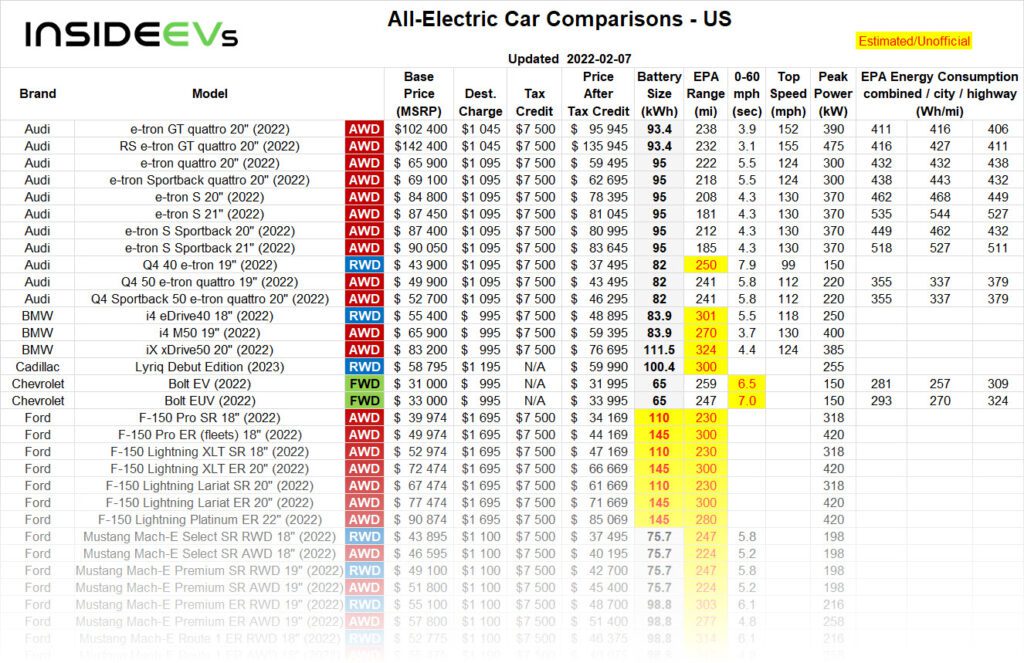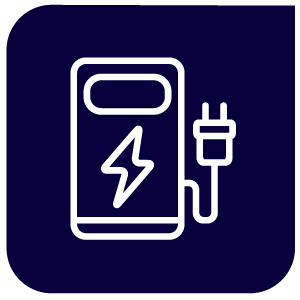
We currently live in the decade that will usher in wide-scale adoption of EVs. So, welcome to the future.
For the second blog post in this EV series, I wanted to provide some practical tips about researching EVs. If you’re thinking about buying an EV, here are some things I learned much later than I should have. Hopefully, you’ll do more upfront research than I did!
Price
EVs currently have an enormous price range, which isn’t overly surprising for a still-maturing industry. In general, EV prices range from $30,000 on the lower end to well over $150,000. In the US alone, the number of EV models has skyrocketed from just 21 in 2015 to a projected 134 models by 2024. Globally, there were over 450 electric car available in 2021 (more than double the number available in 2018).

Lease versus own
My husband and I own a vehicle and lease another vehicle. Our EV is the leased vehicle. Confession: I only bring this up because I wasn’t comfortable fully committing to owning my first EV. The technology is rapidly changing, and I want to be able to take advantage of the latest advancements that many experts are anticipating in the next few years.
Whether you’re planning to buy or lease a new electric vehicle, don’t forget one of the most important steps in the process: Checking out all the free snacks and drinks at the dealership. In retrospect, I wish I had gone to more dealerships!
Mileage (or kilometer) range
Another important consideration is how far you can drive on a single battery charge. Range is determined by two factors, the kWh/mile efficiency and the kWh capacity of the battery pack.
Here are some terms you should get to know:
- Battery capacity: The energy contained in an EV’s battery pack. An EV’s range depends on the size of its battery and how efficiently the EV uses the stored energy.
- Energy capacity: A measurement in kilowatt-hours, or the ability of a battery to deliver a set power output (in kilowatts) over a period of time (in hours). I find this element of EV driving to be the most difficult to predict, because you have to consider factors such as speed and outside temperature. In other words, if you drive like you’re auditioning for Formula 1 on a hot summer day, you’re going to use up your battery charge much faster.
Here’s an EV energy analysis that I found informative.
As a new EV driver, I can tell you another important term to know: “range anxiety.” Trust me—this is a very real thing and it includes a few elements (I’ll explore this topic further in a future post). Range anxiety fundamentally changes how you drive. At the time I’m writing this, I’ve been unable to find an app or a way to predictively model my EV charge consumption. In simple terms, what I mean is:
- Yes, there are range prediction calculators.
- No, (at this moment in time) you cannot plug your destination into your GPS, add your EV model, and get an accurate prediction for your energy consumption.
- NOT ALL MILES IN AN EV ARE EQUAL: If you want to drive a certain number of miles, you need to think about how much of that is stop-and-go driving (where you’ll likely reclaim some energy) and how much is “highway” driving (where you’ll burn energy faster—sometimes burning energy at a faster rate than one mile of charge capacity).
If you’re going to be an EV driver, you’ll need to use some math (yes, there’s math on this quiz) to predict your range. Based on my limited experience with both EVs and math, this requires practicing by driving your vehicle to understand its energy consumption. My personal example is when I hit the accelerator to enter the freeway closest to my home, I actually burn three to four miles of charged capacity versus my expectation that I’d use one mile of charge energy for each mile I drive.
Here’s a resource of range comparisons and tips for maximizing range.
Tax credits
OK, this is far from the sexiest part of the blog post. I read through a lot of tax credit information to write this accurately and I’m still not clear whether I got it right. However, I can accurately tell you this: If you buy an EV or fuel cell vehicle (FCV) in 2023 or after, you may qualify for a clean vehicle tax credit. (Note that you actually have to drive the vehicle—there’s wording in the tax code about the vehicle being “in service.” Not that I necessarily think anyone is going to buy a new EV and then let it sit in the garage for three years, but I felt compelled to drop that bit of knowledge.)
As far as I can tell, we received the maximum tax credit of $7,500. *jazz hands*
Tax credits are one worldwide trend where numerous governments are encouraging EV adoption. The other side of the equation is legislation. Examples include the European Union CO2 emissions regulation for cars and vans, China’s New Energy Vehicles (NEV) mandate, and California’s Zero-Emission Vehicle (ZEV) mandate.
Legislation
I’ve heard that some people are disappointed about the California EV mandate, so I took the time to read the legislation. Here’s what I found:
- Is California making new purchases of electric vehicles mandatory? Yes, but not today.
- When is that deadline? 2035.
- So, people can’t drive internal combustion engine (ICE) vehicles in California after 2035? No, they can still drive them. They just can’t purchase brand new ICE vehicles. The mandate applies only to new vehicle purchases…and the timeframe is still 12 years from now!
Just think of all the advancements we’ve witnessed in the past 12 years. Siri was invented 12 years ago. Yeah, you might have forgotten the time before Siri existed. That’s the point…when it comes to technology getting us closer to where we need to be, 12 years is enough time for massive advancements to occur.
A time for optimism…or hedging bets?
I can already feel some of you rolling your eyes, and you might end up being right. I’ve read the statistics on limited manufacturing capacity and resource constraints. But—if you look at this issue objectively—we’re only going to end up in a better place if we give the technology room to morph into the global solution we need it to be.
As of today, over 20 countries have announced some type of plan to phase out new ICE vehicle sales in the next 10 to 30 years. Moreover, 120 countries (approximately 85% of the global road vehicle fleet) have announced plans to reach net-zero emissions in next few decades. EVs can help us reach that goal.
C-stores at the forefront of the energy transition
I’m not smart enough to know whether that goal is realistic or just wishful thinking. Like a lot of aspects of the energy transition, I think it’s safe to assume that we’ll experience dramatic changes—but the exact timeline will likely depend on the pace of technology advancement and the willingness of consumers to embrace the change.
As many consumers wonder, “Should I buy an EV now or wait?” we likely won’t reach a tipping point of emissions reduction until those consumers make EVs a part of their everyday lives. This is where the convenience industry will play a vital role in the ongoing energy transition.
C-stores are an essential part of many everyday routines, offering a familiar and trusted place where people gravitate for innovative food, services, and retail offerings. With the opportunity to provide vital EV charging infrastructure, c-stores can be a facilitator—or even an accelerator—in that transition.
In the next blog post, we’ll explore how to ask questions and learn about your EV without feeling stupid.
In case you missed the other posts in this series, you can read them here:
- I’m Not an EV Expert, But I Play One on TV
- Learning about Your New EV While Trying to Not Feel Stupid
- How I Ended Up Charging My EV on My Chicken Coop
- What I Learned from Having to Charge My EV on My Chicken Coop
E-mobily yours,
Bethany
EV and Convenience

Learn more about EV and convenience with new resources in the EV Hub.



